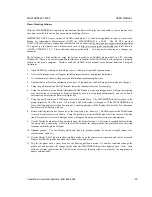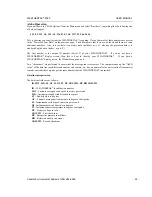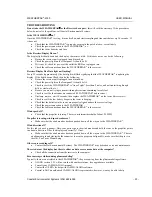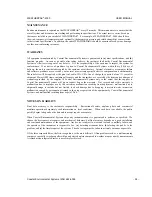
WEATHERPAK
®
-2000 USER
MANUAL
Coastal Environmental Systems (206) 682-6048
- 11 -
MATHEMATICS OF WIND MEASUREMENTS
Wind direction is the compass angle from which
the wind is blowing
Many different wind statistics are in common use. Vector averaging of some sort is necessary for reliable wind
direction estimates. You cannot simply average the vane measurement directly without risking grave errors. As an
example if the wind blew half the time from 359
°
and the other half from 1
°
, the simple vane average would yield a
mean direction of 180
°
!
The compass bearing can be added to the vane measurement for each sample. If the vane direction measurement
relative to the sensor is
θ
s
and the measured corrected compass angle is
α
, the instantaneous wind direction
relative to true north is
θ
t
=
θ
s
+
α
. If you know the magnetic declination
δ
at your site, you should input it to the
WEATHERPAK, using the System Functions Menu (section 0). However, if there are contaminating magnetic
objects in the vicinity of your WEATHERPAK, or if the compass is not installed, then the wind monitor must be
aligned as closely as possible to true north. The flag Add Compass To Vane, also set in the System Functions
Menu, should be set to 0 (false) in this case.
The different wind statistics available are described below. They are all based upon the same measurements: the
wind speed
s
and direction
θ
(including the compass bearing) are measured typically once per second (the rate can
be factory set). From these, the WEATHERPAK calculates the following quantities for each measurement
i
:
x
y
u
s x
v
s y
i
i
i
i
i
i i
i
i i
=
=
=
=
sin
;
cos
;
;
;
θ
θ
giving
x
i
and
y
i
, the unit vector components corresponding to east and north respectively, and
u
i
and
v
i
, the wind
speed vector components. The vector components are summed over the averaging period, and the vector averages
are computed at the end of the averaging interval:
X
N
x
Y
N
y
U
N
u
V
N
v
i
i
N
i
i
N
i
i
N
i
i
N
=
=
=
=
=
=
=
=
∑
∑
∑
∑
1
1
1
1
1
1
1
1
;
;
;
.
Vector Average Wind Speed and Direction
The
U
and
V
terms are used to compute the vector average wind speed
S
V
and direction
θ
V
:
(
)
S
U
V
U V
V
V
=
+
=
2
2
;
arctan
,
.
θ
The arctangent notation (
U
,
V
) means that the signs of
U
and
V
are used to determine the exact angle in the range
of 0-360
°
.



























